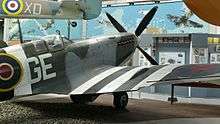349th Squadron (Belgium)
349th Squadron (French: 349e escadrille, Dutch: 349ste Smaldeel) is a fighter squadron in the Air Component of the Belgian Armed Forces. The squadron traces its origins to No. 349 (Belgian) Squadron of the Royal Air Force, founded in 1942 as part of the Free Belgian forces during World War II. It was transferred to the re-established Belgian Air Force in 1946, together with 350th Squadron. Considered an "honorary" squadron, it retained its original name and numbering and has been flying under the Belgian flag ever since. Today it is part of the 10th Tactical Wing, operating the F-16 Fighting Falcon from Kleine Brogel airbase.
| No. 349 (Belgian) Squadron RAF 349th Squadron | |
|---|---|
 Spitfire Mark IXCs of No. 349 (Belgian) Squadron, 1943-4. | |
| Active | 10 November 1942 - May 1943 5 June 1943 - 24 October 1946 1946 – present |
| Country | |
| Branch | |
| Part of | 10th Tactical Wing |
| Motto(s) | Strike Hard, Strike Home |
| Fighter | F-16 Fighting Falcon |
| Commanders | |
| Notable commanders | Raymond Lallemant Frank De Winne |
| Insignia | |
| Squadron Badge | Two morning stars in saltire[1] |
| Squadron Codes | GE (Jan 1943 - Oct 1946) |
History
Royal Air Force (1942–46)
No 349 (Belgian) Squadron was formed as a Royal Air Force squadron by Belgian personnel at RAF Ikeja (near Lagos), Nigeria on 10 November 1942.[1] The squadron was equipped with the Curtiss Tomahawk for local defence duties but the squadron did not become operational as such. The pilots were used for ferrying aircraft to the Middle East instead. The squadron was disbanded in May 1943 and the personnel transferred to the UK. On 5 June 1943, the Squadron was reformed at RAF Station Wittering, operating the Supermarine Spitfire V and became operational at RAF Digby in August 1943. The squadron moved to southern England to operate over France as bomber escorts and low-level sweeps. In early 1944, it began training as a fighter-bomber unit and then operated as such in occupied Europe. During the invasion of Normandy, it carried out beachhead patrols and were used as bomber escorts. In August 1944 the squadron moved to France, in the fighter-bomber role, and carried out armed reconnaissance behind enemy positions, attacking targets of opportunity (mainly vehicles). In February 1945, the squadron returned to England to convert to the Hawker Tempest. This did not go well: conversion ended in April, and the squadron reacquired Spitfire IXs, operating from the Netherlands. It moved to Belgium and was disbanded as an RAF-squadron on 24 October 1946 on transfer to the Belgian Air Force, keeping the number.
Aircraft operated during RAF service

| From | To | Aircraft | Variant | Notes |
|---|---|---|---|---|
| Jan 1943 | Apr 1943 | Curtiss Tomahawk | Mk.I | |
| Jun 1943 | Feb 1944 | Supermarine Spitfire | Mk.V | |
| Feb 1944 | Feb 1945 | Supermarine Spitfire | LF.IXe | |
| Feb 1945 | Apr 1945 | Hawker Tempest | Mk.V | |
| Apr 1945 | May 1945 | Supermarine Spitfire | Mk.IXb | |
| May 1945 | Oct 1946 | Supermarine Spitfire | LF.XVIe |
Commanding officers
| From | To | Name |
|---|---|---|
| Jan 1943 | Jul 1944 | Sqn Ldr Ivan du Monceau de Bergendael, DFC & Bar, CdG |
| Jul 1944 | Mar 1945 | Sqn Ldr Albert Van de Velde |
| Mar 1945 | Dec 1945 | Sqn Ldr Raymond "Cheval" Lallemant, DFC & Bar |
| Dec 1945 | Oct 1946 | Sqn Ldr Albert Van de Velde, DFC |
Belgian Air Force (1946 to present)
In 1946, the unit was integrated in the Belgian Air Force. From 1998, the unit was commanded by future Belgian astronaut Frank De Winne.
From 1957 to 1964, the squadron operated the Avro Canada CF-100 Canuck.
In 1999, the squadron participated in the NATO bombing of Yugoslavia. In 2004, it was the first squadron to be deployed to Siauliai airbase, Lithuania in the context of the Baltic Air Policing operation. In 2005 and 2008 it was deployed to Kabul as part of the ISAF mission in Afghanistan. In 2011, it was part of Operation Unified Protector during the Libyan civil war.
349th Sqn was the first operational F-16 squadron in NATO.
References
- Halley 1988, p. 381.
- Jefford 2001, p. 90.
- Rawlings 1978, p. 416.
Bibliography
- Donnet, Mike and Leon Branders. Ils en Etaient !. Brussels, Belgium: Pierre De Meyere, Editeur, 1979.
- Halley, James J. The Squadrons of the Royal Air Force & Commonwealth, 1918-1988. Tonbridge, Kent, UK: Air-Britain (Historians) Ltd., 1988. ISBN 0-85130-164-9.
- Jefford, C.G. RAF Squadrons, a Comprehensive Record of the Movement and Equipment of all RAF Squadrons and their Antecedents since 1912. Shrewsbury, Shropshire, UK: Airlife Publishing, 2001. ISBN 1-84037-141-2.
- Lallemant, Lt. Colonel R.A. Rendez-vous avec la chance (in French). Paris: Robert Laffont, 1962.
- Rawlings, John D.R. Fighter Squadrons of the RAF and their Aircraft. London: Macdonald and Jane's (Publishers) Ltd., 1969 (new revised edition 1976, reprinted 1978). ISBN 0-354-01028-X.
External links
| Wikimedia Commons has media related to No. 349 (Belgian) Squadron RAF. |